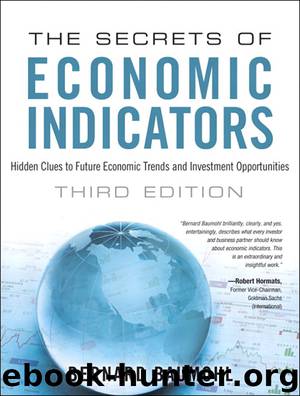The Secrets of Economic Indicators: Hidden Clues to Future Economic Trends and Investment Opportunities, Third Edition (Shawn Kahl's Library) by Bernard Baumohl

Author:Bernard Baumohl
Language: eng
Format: epub
Publisher: FT Press
Published: 2013-11-28T16:00:00+00:00
Source: National Association of Realtors, used with permission.
Just how expensive is it for Americans to buy a home? The NAR assembles a table every month that measures the affordability of purchasing a home given the existing economic climate. This series, called the Housing Affordability Index, can also be found on the NAR Web site (www.realtor.org/topics/housing-affordability-index). Though this measure has virtually no impact on the stock and bond markets, it is included here because home purchases are the single biggest investment that households make in their lifetime. A favorable combination of economic conditions, such as rising personal income and low mortgage rates, makes home buying more affordable and thus sets the stage for more real estate sales in the future.
(7) The Housing Affordability Index tells whether a typical family can qualify for a mortgage loan on a typical home. A typical home is defined here as the national median price of an existing single-family home as calculated by NAR. The outcome can be found in the columns on the right side of the page. An index value of 100 means that a median-income family has exactly enough income to qualify for a mortgage on a median-priced home. An index above 100 signifies that a family earning the median income has more than enough to qualify for a mortgage loan on a median-priced home, assuming a 20% down payment. For example, a composite index of 130 means a family earning the median family income has 130% of the income necessary to qualify for a conventional loan covering 80% of a median-priced existing single-family home.
The NAR assumes a maximum qualifying ratio of 25%, where monthly principal and interest payments cannot exceed 25% of the median family’s monthly income.
Download
This site does not store any files on its server. We only index and link to content provided by other sites. Please contact the content providers to delete copyright contents if any and email us, we'll remove relevant links or contents immediately.
The Brazilian Economy since the Great Financial Crisis of 20072008 by Philip Arestis Carolina Troncoso Baltar & Daniela Magalhães Prates(105752)
International Integration of the Brazilian Economy by Elias C. Grivoyannis(75551)
The Art of Coaching by Elena Aguilar(52202)
Flexible Working by Dale Gemma;(23213)
How to Stop Living Paycheck to Paycheck by Avery Breyer(19570)
The Acquirer's Multiple: How the Billionaire Contrarians of Deep Value Beat the Market by Tobias Carlisle(12114)
Thinking, Fast and Slow by Kahneman Daniel(11802)
The Radium Girls by Kate Moore(11627)
The Art of Thinking Clearly by Rolf Dobelli(9929)
Hit Refresh by Satya Nadella(8863)
The Compound Effect by Darren Hardy(8523)
Atomic Habits: Tiny Changes, Remarkable Results by James Clear(8054)
Tools of Titans by Timothy Ferriss(7824)
Turbulence by E. J. Noyes(7708)
Change Your Questions, Change Your Life by Marilee Adams(7384)
A Court of Wings and Ruin by Sarah J. Maas(7273)
Nudge - Improving Decisions about Health, Wealth, and Happiness by Thaler Sunstein(7255)
How to Be a Bawse: A Guide to Conquering Life by Lilly Singh(7162)
Win Bigly by Scott Adams(6831)
